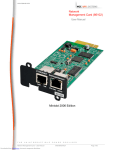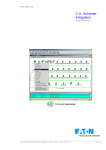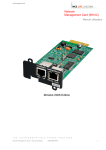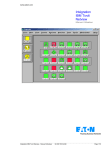Download agent`s MIB description
Transcript
agent’s MIB description
référence
:
reference n°
indice
:
index
34003597XT
page
1/26
:
AA
Iso (1) org (3) dod (6) internet (1)
mgmt (2)
MIB (1)
IETF (33)
AA
04/01/02
Edition originale / First issue
private (4)
enterprise (1)
MGE UPS SYSTEMS (705)
P.Pellegrini
Nom
Name
Ind
date
Modification
Réalisé par
Prepared by
P.Vincent
Visa
Nom
Name
Approuvé par
Approved by
Visa
agent’s MIB description
référence
:
reference n°
indice
:
index
34003597XT
page
2/26
:
AA
contents
1. MG UPS MIB OBJECTS
3
2. IETF UPS MIB OBJECTS
13
3. COMPAQ UPS MIB OBJECTS
16
4. MGE MIB TRAPS
17
5. IETF MIB TRAPS AND ALARMS
20
6. COMPAQ MIB TRAPS
22
7. TRAPS MONITORED BY UM-CLIENT
23
8. MAIN MGE MIB OBJECTS
24
9. REGISTERED TRADEMARKS
26
MGE UPS Systems
agent’s MIB description
2
agent’s MIB description
référence
:
reference n°
indice
:
index
34003597XT
page
3/26
:
AA
1. MG UPS MIB Objects
The MG UPS MIB V1.6 defines all objects for managing UPSs on a Network.
The following OID refers to the entry point of the MG UPS MIB in the Internet tree:
{iso(1).org(3).dod(6).internet(1).private(4).entreprises(1).merlinGerin(705).ups(1)}
1.3.6.1.4.1.705.1.
n 1: upsmgIdent: "UPS Identification Group"
1: upsmgIdentFamilyName:
STRING UPS Family name. i.e. "PULSAR", "GALAXY",
etc.
STRING UPS Model name. i.e. "SV6", "PSX30", etc.
STRING UPS revision level. i.e. "V1.2"
STRING UPS firmware version. i.e. "V1.0"
STRING UPS identification string (user-defined)
STRING UPS installation date (user-defined)
STRING UPS serial number.
2: upsmgIdentModelName:
3: upsmgIdentRevisionLevel:
4: upsmgIdentFirmwareVersion:
5: upsmgIdentUserID:
6: upsmgIdentInstallationDate:
7: upsmgIdentSerialNumber:
1.3.6.1.4.1.705.1.
n 2: upsmgManagement: "UPS Management Group"
1: upsmgManagersNum:
2: upsmgManagersTable:
1: upsmgManagerEntry:
1: mgmanagerIndex.index
2: mgmanagerDeviceNumber.index
3: mgmanagerNMSType.index
4: mgmanagerCommType.index
MGE UPS Systems
Integer Number of managers. (8, 16 or 24 depending
on the Agent)
TABLE Description of all the managers that will
receive traps transmitted by the agent. The table gives
information such as the manager's IP address, the
severity level of the traps to be sent to the manager, or
how the acknowledgment procedure is configured.
TABLE Description of one of the managers in the
Managers table.
Integer Manager's index number in the table, ranging
from 1 to upsmgManagersNum.
Integer An entry is allocated to this object when the
manager is powered by the UPS. It contains the input
number used by the manager in the devices table. If
the manager is not powered by the UPS, this object is
set to 0.
Integer Manager type
- umclient(1),
- decnetview(2),
- umview(3),
- dview(4),
- hpopenview(5),
- sunnetmanager(6),
- novellnms(7),
- ibmnetview(8),
- other(9),
- autolearning(10); this value is used by UM-Link to
register an automatically detected manager.
Integer Communication protocol level used by the
manager:
- other(1): none of the following
agent’s MIB description
3
agent’s MIB description
référence
:
reference n°
indice
:
index
34003597XT
page
4/26
:
AA
- invalid(2): an invalidated manager
- cmip(3): OSI CMIP
- snmpv1(4): SNMPv1
- snmpv2(5): SNMPv2
Value 2 indicates that the corresponding entry is free
in the Managers table.
String Description of the manager.
Internet IP address of the manager's host
workstation.
String Manager's community name. The default value
is "public".
Integer Trap severity level. Maximum severity (from 1
to 7) of traps sent to the manager by the agent. No
traps, with a higher level of severity, will be sent.
Default value: 4
Integer Type of acknowledgment for the associated
manager:
- mgack(1),
- mgnoack(2),
- stdnomg(3),
- mgacks(4),
- cpqnoack(5)
mgack or mgacks indicate that the manager is using
the MGE UPS SYSTEMS trap acknowledgement
system;
mgnoack, ietfnoack and cpqnoack indicate that the
manager (MGE UPS SYSTEMS, IETF, Compaq
respectively) is not using the system.
5: mgmanagerDescr.index
6: mgmanagerAddress.index
7: mgmanagerCommunity.index
8: mgmanagerSeverityLevel.index
9: mgmanagerTrapAck.index
1.3.6.1.4.1.705.1.
n 3: upsmgReceptacle: "UPS Receptacle Group"
1: upsmgReceptaclesNum:
2: upsmgReceptaclesTable:
1: upsmgReceptacleEntry
1: mgreceptacleIndex.index
2: mgreceptacleLevel.index
3: mgreceptacleType.index
4: mgreceptacleIdent.index
5: mgreceptacleState.index
MGE UPS Systems
Integer Number of output receptacles.
TABLE Output Receptacles table, containing
information such as the output ID (user-defined) or
on/off status of the receptacle.
TABLE Description of an entry in the Receptacles
table.
Integer Receptacle index number in the table,
ranging from 1 to upsmgReceptaclesNum.
Integer Receptacle level.
Value 2 indicates that the corresponding entry is
invalid in the table. Values 1 and 4 are reserved.
Values greater than 4 are used to regroup equivalent
receptacles.
String Description of receptacle type.
String Description of receptacle.
Integer Receptacle state:
manualON(1): after manual power-up,
manualOFF(2): after manual shutdown,
normalON(3): after power is restored following a
transfer to battery backup,
normalOFF(4): after shutdown following a transfer to
battery backup,
controlON(5): after a Control ON operation,
controlOFF(6): after a Control OFF operation,
agent’s MIB description
4
agent’s MIB description
référence
:
reference n°
indice
:
index
34003597XT
page
5/26
:
AA
scheduleON(7): after a scheduled power-up,
scheduleOFF(8): after a scheduled shutdown.
6: mgreceptacleReceptacle.index
7: mgreceptaclePowerCons .index
8: mgreceptacleOverload.index
9: mgreceptacleAutonomy.index
Integer Object used to manage logical dependencies
between receptacles. It contains the number of the
top level receptacle. The default value is 0 (the
receptacle does not depend on another receptacle).
Integer Receptacle rated output in Volt-Amperes.
Integer Receptacle overload status
Integer Receptacle battery backup time. (Status)
1.3.6.1.4.1.705.1.
n 4: upsmgConfig: "UPS Configuration Group"
1: upsmgConfigBatteryInstalled
2: upsmgConfigNominalBatteryVoltage
3: upsmgConfigNominalBatteryTime
4: upsmgConfigNominalRechargeTime
5: upsmgConfigMinRechargeLevel:
6: upsmgConfigMaxRechargeTime:
7: upsmgConfigLowBatteryTime:
8: upsmgConfigLowBatteryLevel:
9: upsmgConfigAutoRestart:
10: upsmgConfigShutdownTimer:
11: upsmgConfigSysShutDuration:
12: upsmgConfigVARating
13: upsmgConfigLowTransfer
14: upsmgConfigHighTransfer
15: upsmgConfigOutputNominalVoltage
16: upsmgConfigOutputNominalCurrent
17: upsmgConfigOutputNominalFrequency
18: upsmgConfigByPassType
19: upsmgConfigAlarmAudible
20: upsmgConfigAlarmTimeDelay
21: upsmgConfigDevicesNum:
22: upsmgConfigDevicesTable:
1: upsmgDeviceEntry:
MGE UPS Systems
Integer Battery installation state: yes(1), no(2)
Integer Battery rated voltage. (dV)
Integer Rated battery backup time when fully charged.
(Seconds)
Integer Rated battery total recharge time. (Seconds)
Integer Minimum battery charge level. (%)
Integer Maximum time before restarting UPS.
(Seconds)
Integer Remaining battery backup time. (Seconds)
Integer Minimum battery charge level, at which UPS
shutdown is initiated. (%)
Integer "Automatic restart" status.
always(1)
never(2)
onmain(3)
Integer UPS battery backup time on transfer to
battery. (Seconds)
Integer Battery backup time after shutdown
command. (Seconds)
Integer UPS rated output in Volt-Amperes.
Integer Minimum voltage threshold for transfer to
battery.
Integer Maximum voltage threshold for transfer to
battery.
Integer Rated output voltage (dV).
Integer Rated output current .
Integer Rated output frequency (dHz).
Integer Bypass type:
none(1)
relay(2)
static(3)
Integer Audible alarm state: yes(1), no(2)
Integer Audible alarm time delay. (Seconds)
Integer Number of devices supplied.
TABLE Table listing devices connected to the UPS.
The table contains information such as device ID
(user-defined), VA rating, and the shutdown and
reboot duration.
TABLE Entry in the Devices table.
agent’s MIB description
5
agent’s MIB description
1: mgdeviceIndex.index
2: mgdeviceReceptacleNum.index
3: mgdeviceIdent.index
4: mgdeviceVARating.index
5: mgdeviceSequenceOff.index
6: mgdeviceSequenceOn.index
7: mgdeviceShutdownDuration.index
8: mgdeviceBootUpDuration.index
23: upsmgConfigReceptaclesTable:
1: upsmgCfgReceptEntry
1: mgreceptacleIndex.index
2: mgreceptacleStateTurnOn.index
3: mgreceptacleStateMainReturn.index
4: mgreceptacleStateDischarge.index
5: mgreceptacleShutoffLevel.index
6: mgreceptacleShutoffTimer.index
7: mgreceptacleRestartLevel.index
8: mgreceptacleRestartDelay.index
9: mgreceptacleShutdownDuration.index
10: mgreceptacleBootUpDuration.index
24: upsmgConfigExtAlarmNum:
25: upsmgConfigExtAlarmTable:
MGE UPS Systems
référence
:
reference n°
indice
:
index
34003597XT
page
6/26
:
AA
Integer Device index number in the table, ranging
from 1 to upsmgConfigDevicesNum.
Integer Number of the receptacle to which the device
is connected
String Text description of device.
Integer Volt-Ampere rating of connected device.
Integer Sets position of device in shutdown
sequence.
Integer Sets position of device in reboot sequence.
Integer Time required for device to shutdown.
(Seconds)
Integer Time required for device to reboot. (Seconds)
TABLE UPS Receptacles table, containing
information on the behavior of UPS outputs on battery
back-up, such as the battery backup time for specific
outputs, the delay before restart, and the shutdown
duration of the receptacle which is calculated as a
function of the devices connected to the output.
TABLE Description of an entry in the Receptacles
table.
Integer Receptacle index number in the table,
ranging from 1 to upsmgReceptaclesNum.
Integer State of receptacle at reboot:
on(1)
off(2)
last(3)
schedule(4)
Integer State of receptacle when power is restored:
on(1)
off(2)
last(3)
schedule(4)
Integer State of receptacle upon return transfer
following battery discharge:
on(1)
off(2)
last(3)
schedule(4)
Integer Battery level at which the shutdown sequence
is initiated. (%)
Integer Time delay before initiating shutdown
sequence after transfer to battery.
Integer Battery level at which the restart sequence is
initiated. (%)
Integer Time delay before initiating restart sequence
after shutdown. (Seconds)
Integer Maximum shutdown duration for the devices
supplied by the receptacle. (Seconds)
Integer Maximum restart duration for the devices
supplied by the receptacle. (Seconds)
Integer Number of external alarms.
TABLE Table describing the relay contacts monitored
by the UM–Sensor environment sensor.
agent’s MIB description
6
agent’s MIB description
1: upsmgExtAlarmEntry
référence
:
reference n°
indice
:
index
34003597XT
page
7/26
:
AA
TABLE Description of an entry in the External Alarms
table.
Integer Contact index number in the table, ranging
from 1 to upsmgConfigExtAlarmNum.
Description of relay contact.
Integer Configuration of the SNMP agent to generate
UPS shutdown on reception of negative test event.
Integer Configuration of the SNMP agent to generate
UPS shutdown on reception of transfer to bypass
event.
Integer Configuration of the SNMP agent to generate
UPS shutdown on reception of overload event.
UPS ON/OFF schedule table, indicating, for each day
of the week, the power-on time and power-off time.
TABLE Description of an entry in the scheduled on/off
table.
Integer Index number in the table, ranging from 1 to 7.
Sunday(1)
Monday(2)
etc.
Integer Schedules power-on time. The value must be
entered in seconds starting at 00.00 (midnight). A
value greater than 86400 indicates that no power-on
operation has been scheduled.
Integer Schedules power-off time. The value must be
entered in seconds starting at 00.00 (midnight). A
value greater than 86400 indicates that no power-off
operation has been scheduled.
Integer Low booster threshold. (dV)
Integer High booster threshold. (dV)
Integer Low fader threshold. (dV)
Integer High fader threshold. (dV)
1: mgextAlarmIndex.index
2: mgextAlarmUID.index
26: upsmgConfigEmergencyTestFail:
27: upsmgConfigEmergencyOnByPass:
28: upsmgConfigEmergencyOverload:
29: upsmgConfigControlDayTable:
1: upsmgCtrlDayEntry
1: mgcontrolDayIndex.index
2: mgcontrolDayOn.index
3: mgcontrolDayOff.index
30: upsmgConfigLowBooster:
31: upsmgConfigHighBooster:
32: upsmgConfigLowFader:
33: upsmgConfigHighFader:
1.3.6.1.4.1.705.1.
n 5: upsmgBattery: "UPS battery backup time group"
1: upsmgBatteryRemainingTime:
2: upsmgBatteryLevel:
3: upsmgBatteryRechargeTime
4: upsmgBatteryRechargeLevel
5: upsmgBatteryVoltage
6: upsmgBatteryCurrent
7: upsmgBatteryTemperature:
8: upsmgBatteryFullRechargeTime
9: upsmgBatteryFaultBattery:
10: upsmgBatteryNoBattery:
11: upsmgBatteryReplacement
12: upsmgBatteryUnavailableBattery
13: upsmgBatteryNotHighCharge
MGE UPS Systems
Integer Remaining battery backup time. (Seconds)
Integer Battery charge level. (%)
Integer Recharge time required for the battery level to
reach the level set by upsmgConfigRechargeLevel.
(Seconds)
Integer (%) ( ? ? ?)
Integer Voltage delivered by the battery. (dV) ( ? ? ?)
Integer Current delivered by the battery. ( ? ? ?)
Integer UPS internal temperature. (°C) ( ? ? ?)
Integer Time required to fully recharge the battery.
(Seconds)
Integer Battery fault indicator: yes(1), no(2).
Integer Battery presence indicator: yes(1), no(2).
Integer Battery replacement indicator: yes(1), no(2).
Integer Battery unavailable indicator: yes(1), no(2).
Integer Battery not charged to maximum indicator:
yes(1), no(2).
agent’s MIB description
7
agent’s MIB description
14: upsmgBatteryLowBattery
15: upsmgBatteryChargerFault
16: upsmgBatteryLowCondition
17: upsmgBatteryLowRecharge
référence
:
reference n°
indice
:
index
34003597XT
page
8/26
:
AA
Integer Low battery indicator: yes(1), no(2).
Integer Charger fault indicator: yes(1), no(2).
Integer State indicating that battery has entered low
condition: yes(1), no(2).
Integer Low battery recharge indicator: yes(1), no(2).
n 6: upsmgInput: "UPS input group"
1: upsmgInputPhaseNum:
2: upsmgInputPhaseTable:
1: upsmgInputPhaseEntry
1: mginputIndex.index
2: mginputVoltage.index
3: mginputFrequency.index
4: mginputMinimumVoltage.index
5: mginputMaximumVoltage.index
6: mginputCurrent.index
3: upsmgInputBadStatus:
4: upsmgInputLineFailCause
Integer Number of input phases.
TABLE Phase state table, including information such
as the input phase voltage, frequency and current.
TABLE Description of an entry in the Inputs table.
Integer Index number in the table, ranging from 1 to
upsmgInputPhaseNum.
Integer Input voltage. (dV)
Integer Input frequency. (dHz)
Integer Minimum voltage of phase during the
previous minute. (dV)
Integer Maximum voltage of phase during the
previous minute. (dV)
Integer Input current. ()
Integer Incorrect input voltage or frequency: yes(1),
no(2).
Integer Cause of outage:
no(1): no outage
outoftolvolt(2): voltage out of tolerance
outoftolfreq(3): frequency out of tolerance
utilityoff(4): no voltage.
1.3.6.1.4.1.705.1.
n 7: upsmgOutput: "UPS output group"
1: upsmgOutputPhaseNum:
2: upsmgOutputPhaseTable:
1: upsmgOutputPhaseEntry
1: mgoutputPhaseIndex.index
2: mgoutputVoltage.index
3: mgoutputFrequency.index
4: mgoutputLoadPerPhase.index
5: mgoutputCurrent.index
3: upsmgOutputOnBattery:
4: upsmgOutputOnByPass
5: upsmgOutputUnavailableByPass
6: upsmgOutputNoByPass
7: upsmgOutputUtilityOff
8: upsmgOutputOnBoost
9: upsmgOutputInverterOff
MGE UPS Systems
Integer Number of output phases.
TABLE Phase state table, including information such
as the output phase voltage, frequency, current and
load.
TABLE Description of an entry in the Outputs table.
Integer Index number in the table, ranging from 1 to
upsmgOutputPhaseNum.
Integer Output voltage. (dV)
Integer Output frequency. (dHz)
Integer Load per phase. (%)
Integer Output current. () ( ? ? ?)
Integer UPS is on battery: yes(1), no(2)
Integer Bypass state: yes(1), no(2)
Integer Bypass not available: yes(1), no(2)
Integer Bypass not installed: yes(1), no(2)
Integer UPS in battery backup time: yes(1), no(2)
Integer Output on booster indicator: yes(1), no(2)
Integer Inverter state. yes(1), no(2)
agent’s MIB description
8
agent’s MIB description
10: upsmgOutputOverLoad
11: upsmgOutputOverTemp
12: upsmgOutputOnBuck
référence
:
reference n°
indice
:
index
34003597XT
page
9/26
:
AA
Integer Overload indicator: yes(1), no(2)
Integer Excess temperature indicator: yes(1), no(2)
Integer Transfer to fader indicator: yes(1), no(2)
1.3.6.1.4.1.705.1.
n 8: upsmgEnviron: "UPS environment group"
1: upsmgEnvironAmbientTemp:
2: upsmgEnvironAmbientHumidity:
3: upsmgEnvironExtAlarmTable:
1: upsmgEnvironExtAlarmEntry
1: mgalarmNum .index
2: mgalarmState.index
4: upsmgEnvironSensorNum:
5: upsmgEnvironSensorTable:
1: upsmgEnvironSensorEntry
1: mgEvnIndex.index
2: mgEvnTemperature.index
3: mgEvnHumidity.index
Integer Ambient temperature measured by UM–
Sensor 1. ()
Integer Relative humidity measured by UM–Sensor 1.
()
TABLE Table indicating the state of the relay contacts
monitored by UM-Sensor.
TABLE Description of an entry in the External Alarms
table.
Integer Table index number.
Integer External relay contact state.
Integer Number of UM-Sensor units (0 to 4).
Integer Table containing measurements made by
UM-Sensor units.
Description of an entry in the Measurements table.
Integer Index number in the table, ranging from 1 to
upsmgEnvironEnvironNum.
Integer Temperature measurement. ()
Integer Humidity measurement. ()
1.3.6.1.4.1.705.1.
n 9: upsmgControl: "UPS control group"
1: upsmgControlReceptaclesTable:
1: upsmgCtrlReceptEntry
1: mgreceptacleIndexc.index
2: mgreceptacleOnDelay.index
3: mgreceptacleOnCtrl.index
4: mgreceptacleOnStatus.index
5: mgreceptacleOffDelay.index
6: mgreceptacleOffCtrl.index
MGE UPS Systems
TABLE Receptacles table, indicating the (userdefinable) objects for controlling the on/off sequences
of UPS outputs.
TABLE Description of an entry in the Receptacles
table.
Integer Receptacle index number in the table,
ranging from 1 to upsmgReceptaclesNum.
Integer Time delay before powering up receptacle
during a Control ON sequence. (Seconds)
Integer Object used to trigger or stop the Control ON
sequence:
nothing(1)
start(2)
stop(3)
Integer Control ON sequence state
none(1)
started(2)
inprogressinups(3)
completed(4)
Integer Time delay before starting a shutdown
sequence during a Control OFF operation. (Seconds)
Integer Object used to trigger or stop the Control OFF
sequence:
nothing(1)
agent’s MIB description
9
agent’s MIB description
7: mgreceptacleOffStatus.index
8: mgreceptacleToggleDelay.index
9: mgreceptacleToggleCtrl.index
10: mgreceptacleToggleStatus.index
11: mgreceptacleToggleDuration.index
2: upsmgControlDayOff:
3: upsmgControlDayOn:
référence
:
reference n°
indice
:
index
34003597XT
page
10/26
:
AA
start(2)
stop(3)
Integer Control OFF sequence state
none(1)
started(2)
inprogressinups(3)
completed(4)
Integer Time delay before starting a shutdown
sequence during a Toggle OFF/ON operation.
(Seconds)
Integer Object used to initiate or stop the Toggle
OFF/ON sequence:
nothing(1)
start(2)
stop(3)
Integer Toggle OFF/ON sequence state
none(1)
started(2)
inprogressinups(3)
completed(4)
Integer Receptacle shutdown time delay during
Toggle OFF/ON sequence.
Integer Triggers scheduled UPS shutdown. yes(1),
no(2)
Integer Triggers receptacle reboot after scheduled
shutdown. yes(1), no(2)
1.3.6.1.4.1.705.1.
n 10: upsmgTest: "UPS test group "
1: upsmgTestBatterySchedule
2: upsmgTestDiagnostics:
3: upsmgTestDiagResult
4: upsmgTestBatteryCalibration:
5: upsmgTestLastCalibration
6: upsmgTestIndicators
7: upsmgTestCommandLine:
8: upsmgTestCommandReady:
9: upsmgTestResponseLine:
10: upsmgTestResponseReady:
11: upsmgTestBatteryResult:
Integer Schedules automatic battery test for UPSs
that support this function.
Integer Starts the diagnostics program: default(1),
start(2).
Integer Result of test: success(1), failed(2), none(3)
Integer Starts the battery test: default(1), start(2).
String Date of previous test.
Integer Starts the UPS indicator test: default(1),
start(2).
String Transmits a line of ASCII commands to the
UPS.
Integer Warns UPS that the command line is ready.
yes(1), no(2)
String Enables receipt of ASCII response from UPS.
Integer Informs agent that response has been
received. yes(1), no(2)
Integer Result of previous battery test. ( ? ? ?)
1.3.6.1.4.1.705.1.
n 11: upsmgTraps: "UPS trap group"
There are no objects defined for this group.
Refer to the section entitled "MGE MIB specific traps"
1.3.6.1.4.1.705.1.
MGE UPS Systems
agent’s MIB description
10
agent’s MIB description
référence
:
reference n°
indice
:
index
34003597XT
page
11/26
:
AA
n 12: upsmgAgent: "UPS agent group"
1: upsmgAgentIpAddress:
2: upsmgAgentSubnetMask:
3: upsmgAgentDefGateway:
4: upsmgAgentBaudRate:
5: upsmgAgentPollRate:
6: upsmgAgentType
7: upsmgAgentTrapAlarmDelay:
8: upsmgAgentTrapAlarmRetry:
9: upsmgAgentReset:
10: upsmgAgentFactReset:
11: upsmgAgentMibVersion
12: upsmgAgentFirmwareVersion
13: upsmgAgentCommUPS:
14: upsmgAgentTrapAck:
15: upsmgAgentAutoLearning:
16: upsmgAgentBootP:
17: upsmgAgentTFTP:
18: upsmgAgentTrapSignature:
Internet IP address of UM–Agent host workstation.
Internet Sub-network mask indicating network class.
Internet IP address of default gateway (if applicable)
Integer Communications port transmission speed
(mandatorily 2400 bauds)
Integer Frequency at which the agent polls the
connected UPS with ASCII commands. (DO NOT
MODIFY)
Integer Type of agent:
UM-Link Ethernet (1)
UM-Agent Ethernet (3)
Other(5)
Integer Delay, before a trap is retransmitted if it has
not been acknowledged.
Integer Record of the number of times a trap is
retransmitted if it is not acknowledged.
Integer Resets agent. yes(1), no(2)
Integer Resets MIB to default (factory) settings.
yes(1), no(2)
Integer Version of MIB being implemented.
Integer Version of agent.
Integer State of communication with UPS.
No communication (2).
The other values of the object depend on the devices
connected to the communications path.
The value is calculated using the following formula:
1000*NSE+100*NSW+10*UPSW+UPST
where
- UPST: UPS type (5: no UPS, 3: Protocol Interface,
1: UPS)
- UPSW: number of switchable receptacles on UPS
- NSW: number of UM-Switch(s)
- NSE: number of UM-Sensor(s).
Integer Object used by certain Managers to
acknowledge traps.
Integer Configures automatic learning (1) enable, (2)
Disable.
Integer Configures the BootP process (1) enable, (2)
Disable.
Integer Configures the TFTP downloading process
(1) enable, (2) Disable.
Integer Signature transmitted with traps.
1.3.6.1.4.1.705.1.
n 13: upsmgRemote: "Source UPS group"
1: upsmgRemoteOnBattery:
MGE UPS Systems
Integer This object enables a manager to indicate the
state of the source UPS. This object is only
accessible if the configuration managed by the agent
does not comprise a UPS.
RemoteOnBattery(1)
RemoteReturnFromBattery(2)
agent’s MIB description
11
agent’s MIB description
2: upsmgRemoteIpAddress:
MGE UPS Systems
référence
:
reference n°
indice
:
index
34003597XT
page
12/26
:
AA
RemoteBatteryFault(3)
RemoteOverLoad(4)
Internet IP address of the agent for the source UPS.
agent’s MIB description
12
agent’s MIB description
référence
:
reference n°
indice
:
index
34003597XT
page
13/26
:
AA
2. IETF UPS MIB Objects
The IETF UPS MIB defines standard objects for managing UPSs on a network. The MIB is defined in ASN.1
format in the Request For Comment RFC1628.
The standard IETF UPS-MIB, as implemented by UM–Agent, enables any management application using the
MIB to see, monitor and manage the UPSs controlled by the agent.
The ASN.1 definition of this IETF UPS MIB uses new SNMPv2 capabilities from:
n RFC-1442 (Structure of Management Information)
n RFC-1443 (Textual Conventions)
n RFC-1444 (Conformance Statements)
The first group in this MIB (upsObjects(1) includes nine groups of objects that are implemented in UM–Agent. A
short description of these objects is given in this section.
The following OID refers to the entry point of the IETF UPS MIB in the Internet tree structure:
{iso(1).org(3).dod(6).internet(1).mgmt(2).mib(1).upsMIB(33)}
n 1: upsIdent: "Device identification group"
1: upsIdentManufacturer:
2: upsIdentModel:
3: upsIdentUPSSoftware:
4: upsIdentAgentSoftwareVersion:
5: upsIdentName:
6: upsIdentAttachedDevices:
Name of UPS manufacturer.
see upsmgIdentModelName for MGE MIB.
see upsmgIdentFirmwareVersion for MGE MIB.
see upsmgAgentVersion for MGE MIB.
see upsmgIdentUserID for MGE MIB.
see Devices table for MGE MIB.
n 2: upsBattery: "Battery backup time group"
1: upsBatteryStatus:
2: upsBatterySecondsOnBattery:
3: upsBatteryEstimatedMinutesRemaining:
4: upsBatteryEstimatedChargeRemaining:
5: upsBatteryVoltage:
6: upsBatteryCurrent:
7: upsBatteryTemperature:
see battery state trap indicator for MGE MIB.
Battery backup time used.
see upsmgBatteryRemainingTime for MGE MIB.
see upsmgBatteryLevel for MGE MIB.
see upsmgBatteryVoltage for MGE MIB.
see upsmgBatteryCurrent for MGE MIB.
see upsmgBatteryTemperature for MGE MIB.
n 3: upsInput: "Inputs group"
1: upsInputLineBads:
2: upsInputNumLines
3: upsInputTable
1: upsInputEntry
1: upsInputLineIndex:
2: upsInputLineFrequency:
3: upsInputLineVoltage:
4: upsInputLineCurrent:
5: upsInputLineTruePower:
MGE UPS Systems
Out of tolerance condition counter.
see upsmgInputPhaseNum for MGE MIB.
see mginputIndex for MGE MIB
see mginputFrequency for MGE MIB
see mginputVoltage for MGE MIB
see mginputCurrent for MGE MIB.
Active input power in Watts.
agent’s MIB description
13
agent’s MIB description
référence
:
reference n°
indice
:
index
34003597XT
page
14/26
:
AA
n 4: upsOutput: "Outputs group"
1: upsOutputSource:
2: upsOutputFrequency:
3: upsOutputNumLines:
4: upsOutputTable
1: upsOutputEntry
1: upsOutputLineIndex:
2: upsOutputVoltage:
3: upsOutputCurrent:
4: upsOutputPower:
5: upsOutputPercentLoad:
see battery state trap indicator for MGE MIB.
see mgoutputFrequency for MGE MIB.
see upsmgOutputPhaseNum for MGE MIB.
see mgoutputPhaseIndex for MGE MIB
see mgoutputVoltage for MGE MIB
see mgoutputCurrent for MGE MIB
Output power in Watts.
see mgoutputLoadPerPhase for MGE MIB.
n 5: upsBypass: "Bypass group"
The bypass group corresponds to the MG-MIB output group when UPS is on bypass.
1: upsBypassFrequency
2: upsBypassNumLines
3: upsBypassTable
1: upsBypassEntry
1: upsBypassLineIndex
2: upsBypassVoltage
3: upsBypassCurrent
4: upsBypassPower
n 6: upsAlarm: "IETF alarms group "
1: upsAlarmPresent:
2: upsAlarmTable:
1: upsAlarmEntry
1: upsAlarmId
2: upsAlarmDescr
3: upsAlarmTime
3: upsWellKnownAlarms:
Number of active IETF alarms.
Table of defined IETF alarms.
Defines 24 alarms. See "IETF traps and alarms".
n 7: upsTest: "Test group"
1: upsTestId:
2: upsTestSpinLock:
3: upsTestResultsSummary:
4: upsTestResultsDetail:
5: upsTestStartTime:
6: upsTestElapsedTime:
7: upsWellKnownTests:
1: upsTestNoTestsInitiated:
2: upsTestAbortTestIn-Progress:
MGE UPS Systems
Start/abort control of defined tests.
Spin lock on test subsystem.
Results of previous or current diagnostics test.
Additional information on test results.
Time (sysUpTime) of previous test.
Duration of previous test.
Defines 5 tests.
No test requested and none under way.
Current test will be interrupted.
agent’s MIB description
14
agent’s MIB description
3: upsTestGeneralSystem-Test:
4: upsTestQuickBatteryTest:
5: upsTestDeepBatteryTest:
référence
:
reference n°
indice
:
index
34003597XT
page
15/26
:
AA
Standard manufacturers test for UPSs.
Test to establish whether the battery needs to be
replaced.
As the system is transferred to the battery at a charge
level that is set by the manufacturer, it is possible to
establish precisely the length of battery service life
and, consequently, when it should be replaced.
n 8: upsControl: "Control Group"
1: upsShutdownType:
2: upsShutdownAfterDelay:
3: upsStartupAfterDelay:
4: upsRebootWithDuration:
5: upsAutoRestart:
Choice between output off and system off.
Controls output or system off sequence (start/stop).
Controls output or system on sequence (start/stop).
Controls UPS toggle operation (start/stop).
Configures automatic restart after shutdown.
n 9: upsConfig: "Configuration group"
1: upsConfigInputVoltage:
2: upsConfigInputFreq:
3: upsConfigOutputVoltage:
4: upsConfigOutputFreq:
5: upsConfigOutputVA:
6: upsConfigOutputPower:
7: upsConfigLowBattTime:
8: upsConfigAudibleStatus:
9: upsConfigLowVoltageTransferPoint:
10: upsConfigHighVoltageTransferPoint:
MGE UPS Systems
Rated input voltage.
Rated input frequency.
see upsmgConfigOutputVoltage for MGE MIB.
see upsmgConfigOutputFrequency for MGE MIB.
see upsmgConfigVARating for MGE MIB.
Rated active load.
see upsmgConfigLowBatteryTime for MGE MIB.
see upsmgConfigAlarmAudible for MGE MIB.
see upsmgConfigLowTransfer for MGE MIB.
see upsmgConfigHighTransfer for MGE MIB.
agent’s MIB description
15
agent’s MIB description
référence
:
reference n°
indice
:
index
34003597XT
page
16/26
:
AA
3. COMPAQ UPS MIB Objects
ATTENTION: This functionality is only implemented on certain systems.
The COMPAQ UPS MIB defines COMPAQ objects for managing UPSs on a network. The following OID refers to
the entry point of the COMPAQ UPS MIB in the Internet tree structure:
{iso(1).org(3).dod(6).internet(1).private(4).entrereceptacles(1).Compaq(232).cpqUps(12)}
UM-Agent manages the following objects in the MIB:
n 1: cpqUpsMibRev: "MIB revision group"
1: cpqUpsMibRevMajor:
2: cpqUpsMibRevMinor:
3: cpqUpsMibCondition:
Major version of the implemented MIB.
Major version of the implemented MIB.
Overall state of system.
n 2.1.4 cpqUpsOsCommon: "Modules group"
1: cpqUpsOsCommonPollFreq:
2: cpqUpsOsCommonModule-Table:
1: cpqUpsOsCommonModule-Entry
1: cpqUpsOsCommonModule-Index:
2: cpqUpsOsCommonModule-Name:
3: cpqUpsOsCommonModule-Version:
4: cpsUpsOsCommonModule-Date:
5: cpqUpsOsCommonModule-Purpose:
Frequency at which agent polls the UPS.
Modules table.
Index on the described software module.
Name of software module.
Version of software module.
Date of software module version.
Commentary on the purpose of the software module.
n 2.2: cpqUpsBasic: "Basic measurements group"
1: cpqUpsLineStatus:
2: cpqUpsName:
3: cpqUpsEstmatedBatteryLife:
4: cpqUpsAutoShutdownDelay:
MGE UPS Systems
Mains state at UPS input.
UPS type.
Estimated battery operation.
Time before automatic shutdown.
agent’s MIB description
16
agent’s MIB description
référence
:
reference n°
indice
:
index
34003597XT
page
17/26
:
AA
4. MGE MIB traps
The UM–Agent will send SNMP traps to the management stations which are configured in the MGE MIB UPS
Management group.
Traps are error or warning messages sent to the managers. The messages may concern any of the folowing
events that may occur on the UPS:
n errors,
n state changes,
n operations.
Traps are classified by level, each level corresponding to the degree of severity of the event. Level 1
corresponds to the most serious events.
Only traps up to the configured Trap Level are sent from UM–Agent to the manager. The default Trap Level of
any manager is 4.
Most of the traps are grouped in pairs, with one trap indicating a fault on the UPS and the second one indicating
that the UPS has returned to its normal state.
The following list details various pairs of traps, with their level of severity and meaning.
1:upsBatteryFault (level 2)
2:upsBatteryOK
UPS battery fault status
3:upsBatteryReplacementIndicated (level 3)
4:upsBatteryReplacementNotIndicated
UPS battery replacement indicator
5:upsAtLowBattery (level 1)
6:upsFromLowBattery
UPS low battery internal indicator
7:upsChargerFault (level 3)
8:upsChargerOK
UPS battery charger fault status
9:upsAtLowCondition (level 1)
10:upsFromLowCondition
UPS battery minimum condition status
11:upsOnBattery (level 1)
12:upsReturnFromBattery
UPS on battery backup status
13:upsOnByPass (level 2)
14:upsReturnFromByPass
UPS on bypass status
15:upsByPassUnavailable (level 3)
16:upsByPassAvailable
UPS bypass unavailable/available
17:upsUtilityFailure (level 2)
18:upsUtilityRestored
UPS mains input failure indicator
19:upsOnBoost (level 3)
20:upsReturnFromBoost
UPS booster feature enabled
MGE UPS Systems
agent’s MIB description
17
agent’s MIB description
référence
:
reference n°
indice
:
index
34003597XT
page
18/26
21:upsOverLoad (level 2)
22:upsLoadOK
UPS load in excess of rated value
23:upsOverTemperature (level 2)
24:upsTemperatureOK
Incorrect UPS internal temperature
37:upsCommunicationFailure (level 1)
38:upsCommunicationRestored
State of serial communication with UPS
39:upsInputBad (level 3)
40:upsInputOK
Incorrect input voltage or frequency
41:upsBatteryUnavailable (level 3)
42:upsBatteryAvailable
UPS battery unavailable
43:upsAtLowRecharge (level 4)
44:upsFromLowRecharge
UPS awaiting restart condition
45:upsDiagnosticTestFail (level 3)
46:upsDiagnosticTestOK
UPS internal self test state
47:upsBatteryTestOK (level 3)
48:upsBatteryTestFail
UPS battery test state
49:upsExternalAlarmActive (level 2)
50:upsExternalAlarmInactive
External alarm state
51:upsOnBuck (level 3)
52:upsReturnFromBuck
Activation of UPS fader
:
AA
Other traps are used to report current UPS and agent events.
Whereas the events listed above are related to a particular state of the UPS, the events described below
correspond to more complex operations that require additional information to be sent to the managers. The
information is sent to the manager in the form of a data packet associated with the trap containing both the OID
and the value of the information.
These traps are mainly used for on/off sequences on UPS outputs.
The information associated with the trap is sent to the manager in such a way as to enable it to determine the
exact delay before initiating the operation.
The following list details these traps, and their level of severity, with a brief explanation.
A toggle operation involves turning a UPS output off and then on again.
25:upsOnToStart (level 2)
26:upsOnAbort
27:upsOnInProgress (niveau 1)
28:upsOnComplete
UPS on procedure initiated
UPS on procedure cancelled
UPS on procedure under way
UPS on procedure finished
29:upsOffToStart (level 2)
30:upsOffAbort
31:upsOffInProgress (niveau 1)
UPS off procedure initiated
UPS off procedure cancelled
UPS off procedure under way
MGE UPS Systems
agent’s MIB description
18
agent’s MIB description
référence
:
reference n°
indice
:
index
34003597XT
page
19/26
32:upsOffComplete
UPS off procedure finished
33:upsToggleToStart (level 2)
34:upsToggleAbort
35:upsToggleInProgress (niveau 2)
36:upsToggleComplete
UPS toggle operation initiated
UPS toggle operation cancelled
UPS toggle operation under way
UPS toggle operation finished
49:upsExternalAlarmActive (level 2)
50:upsExternalAlarmInactive
External environment alarm on
External environment alarm off
:
AA
All these traps are defined as specific SNMP traps in version 1.6 of the MGE MIB.
MGE UPS Systems
agent’s MIB description
19
agent’s MIB description
référence
:
reference n°
indice
:
index
34003597XT
page
20/26
:
AA
5. IETF MIB traps and alarms
UM–Agent can be configured to send IETF traps instead of MG enterprise-specific SNMP traps. Each manager
can be configured individually.
The second group of the IETF UPS MIB (upsTraps(2)) defines four kinds of message that are implemented by
UM–Agent.
1: upsTrapOnBattery
2: upsTrapTestCompleted
3: upsTrapAlarmEntryAdded
4: upsTrapAlarmEntryRemoved
The UPS is operating on battery power. The trap is
retransmitted at one minute intervals until the UPS is
either shutdown or no longer running on battery.
Trap sent upon completion of a UPS diagnostic test.
Trap sent each time an alarm is entered in the
Alarms table, except for upsAlarmOnBattery and
upsAlarmTestInProgress alarms.
Alarm sent each time an alarm is deleted from the
Alarms table, except for upsAlarmTestInProgress
alarms.
The data accompanying these traps provides the manager with information on the corresponding entry in the
Alarms table.
The following is a list of the most common alarms that are added to or removed from the Alarms table:
1: upsAlarmBatteryBad
2: upsAlarmOnBattery
3: upsAlarmLowBattery
4: upsAlarmDepletedBattery
5: upsAlarmTempBad
6: upsAlarmInputBad
7: upsAlarmOutputBad
8: upsAlarmOutputOverload
9: upsAlarmOnBypass
10: upsAlarmBypassBad
11: upsAlarmOutputOffAsRequested
12: upsAlarmUpsOffAsRequested
13: upsAlarmChargerFailed
14: upsAlarmUpsOutputOff
15: upsAlarmUpsSystemOff
16: upsAlarmFanFailure
17: upsAlarmFuseFailure
18: upsAlarmGeneralFault
19: upsAlarmDiagnosticTestFailed
20: upsAlarmCommunicationsLost
21: upsAlarmAwaitingPower
MGE UPS Systems
UPS battery fault: one or more batteries require
replacement.
UPS is on battery backup
UPS has entered low condition. The remaining
battery backup time is less than or equal to
upsConfigLowBattTime.
UPS has reached the end of the backup time and is
about to shutdown
UPS internal temperature is out of tolerance
An input condition is out of tolerance
An output condition (other than OutputOverload) is out
of tolerance
Output load exceeds rated capacity of UPS
UPS output is on bypass
UPS bypass out of tolerance
UPS output turned off by Control Group
UPS shutdown command executed
An uncorrected problem has been detected in the
UPS charger subsystem
UPS output has been turned off
UPS has been turned off
Failure detected on one or more UPS fans
Failure detected on one or more UPS fuses
A general fault in the UPS has been detected
Failure detected by previous diagnostic test
A communications problem between the agent and
UPS has been detected
UPS output has been turned off and UPS is waiting
for input power to be restored
agent’s MIB description
20
agent’s MIB description
22: upsAlarmShutdownPending
23: upsAlarmShutdownImminent
24: upsAlarmTestInProgress
MGE UPS Systems
référence
:
reference n°
indice
:
index
34003597XT
page
21/26
:
AA
Countdown after shutdown (upsShutdownAfterDelay)
in progress
upsShutdownAfterDelay countdown elapsed,
shutdown imminent
UPS test in progress
agent’s MIB description
21
agent’s MIB description
référence
:
reference n°
indice
:
index
34003597XT
page
22/26
:
AA
6. COMPAQ MIB traps
UM–Agent can be configured to send COMPAQ traps instead of MG enterprise-specific SNMP traps. Each
manager can be configured individually.
1: cpqUpsLineFailed
2: cpqUpsLineOk
3: cpqUpsShutdown
4: cpqUpsConfirmation
5: cpqUpsBatteryLow
MGE UPS Systems
Mains power has failed.
Mains power has been restored.
The system shutdown procedure has been initiated.
The system is operational again following a
shutdown caused by a power failure.
UPS battery charge is low.
agent’s MIB description
22
agent’s MIB description
référence
:
reference n°
indice
:
index
34003597XT
page
23/26
:
AA
7. Traps monitored by UM-Client
UM-Client are distributed basic management applications running on host systems, that provide domain alarm
messages and shutdown script initiation activated by acknowledged SNMP traps received from MGE UPS
SYSTEMS agents.
UM-Client provides provides reliable cross-platform fail-safe shutdown of multiple distributed hosts powered by
mid-range and large MGE UPS SYSTEMS SNMP instrumented UPS’s.
It is recommended to use UM-Link configured with Auto-Learning disabled, in order to work easily with UMClient.
Following is a list of MGE traps which are monitored by the UM-Client :
Trap Level 1 :
9 upsAtLowCondition
31:upsOffInProgress
37:upsCommunicationFailure
38:upsCommunicationRestored
UPS battery minimum condition status
UPS off procedure under way
State of serial communication with UPS
Trap Level 2 :
1:upsBatteryFault
13:upsOnByPass
17:upsUtilityFailure
18:upsUtilityRestored
29:upsOffToStart
UPS battery fault status
UPS on bypass status
UPS mains input failure indicator
UPS mains input restored
UPS off procedure initiated
UM-Client acknoledges reception of these traps.
For more information, please refer to the UM-Client User Manual.
MGE UPS Systems
agent’s MIB description
23
agent’s MIB description
référence
:
reference n°
indice
:
index
34003597XT
page
24/26
:
AA
8. Main MGE MIB objects
Useful SNMPM commands :
Snmpm get @ip 1.3.6.1.4.1.705.1.1.1.0
1.3.6.1.4.1.705.1.1.1.0 (String)=[Pulsar]
Snmpm set @ip 1.3.6.1.4.1.705.1.1.1.0 String Nom
1.3.6.1.4.1.705.1.1.1.0 (String)=[Nom]
Snmpm /c :public /gp :161 next @ip 1.3.6.1.4.1.705.1.1.1.0
1.3.6.1.4.1.705.1.1.2.0 (String) =[4.5]
For specifying community name (default :public) : /c :community_name
For specifying SNMP get port (default :161) : /gp :161
Main MGE MIB objects are the following ones :
n Group5: upsmgBattery: "UPS battery backup time group"
1: upsmgBatteryRemainingTime:
2: upsmgBatteryLevel:
5: upsmgBatteryVoltage
Remaining battery backup time.
Battery charge level.
Voltage delivered by the battery.
n Group6: upsmgInput: "UPS input group"
2: upsmgInputPhaseTable:
1: upsmgInputPhaseEntry
2: mginputVoltage
3: mginputFrequency
6: mginputCurrent
Phase state table, including information such as the
input phase voltage, frequency and current.
Description of an entry in the Inputs table.
Input voltage.
Input frequency.
Input current.
n Group7: upsmgOutput: "UPS output group"
2: upsmgOutputPhaseTable:
1: upsmgOutputPhaseEntry
2: mgoutputVoltage
3: mgoutputFrequency
4: mgoutputLoadPerPhase
5: mgoutputCurrent
Phase state table, including information such as the
output phase voltage, frequency, current and load.
Description of an entry in the Outputs table.
Output voltage.
Output frequency.
Load per phase.
Output current.
n Group9: upsmgControl: "UPS control group"
1: upsmgControlReceptaclesTable:
1: upsmgCtrlReceptEntry
2: mgreceptacleOnDelay
3: mgreceptacleOnCtrl
MGE UPS Systems
Receptacles table, indicating the (user-definable)
objects for controlling the on/off sequences of UPS
outputs.
Description of an entry in the Receptacles table.
Time delay before powering up receptacle during a
Control ON sequence.
Object used to trigger or stop the Control ON
sequence:
agent’s MIB description
24
agent’s MIB description
4: mgreceptacleOnStatus
5: mgreceptacleOffDelay
6: mgreceptacleOffCtrl
7: mgreceptacleOffStatus
MGE UPS Systems
référence
:
reference n°
indice
:
index
34003597XT
page
25/26
:
AA
nothing(1) / start(2) / stop(3)
Control ON sequence state
none(1) / started(2) / inprogressinups(3) /
completed(4)
Time delay before starting a shutdown sequence
during a Control OFF operation.
Object used to trigger or stop the Control OFF
sequence:
nothing(1) / start(2) / stop(3)
Control OFF sequence state
none(1) / started(2) / inprogressinups(3) /
completed(4)
agent’s MIB description
25
agent’s MIB description
référence
:
reference n°
indice
:
index
34003597XT
page
26/26
:
AA
9. registered trademarks
UM–Client, UM–Link, UM–Agent, UM–Console, UM–View, UM-Editor and UM-Sensor are registered trademarks
of MGE UPS SYSTEMS.
NetWare is a registered trademark of Novell Inc.
OS/2 is a registered trademark of International Business Machines Corporation.
Windows, Windows NT and Windows 95 are registered trademarks of Microsoft Corporation.
SCO UNIX is a registered trademark of The Santa Cruz Operations.
HPUX is a registered trademark of Hewlett-Packard Company.
UNIX is a registered trademark of UNIX System Laboratories Inc.
Other brand and product names are registered trademarks of their respective holders .
MGE UPS Systems
agent’s MIB description
26

































